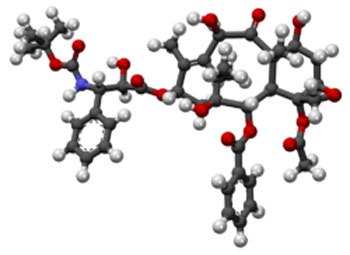Nanoparticle-Delivered Drug Cocktail Blocks Spread of Malignant Melanoma Through the Lymph System
By LabMedica International staff writers
Posted on 21 Dec 2015
A nanoparticle-based delivery system was used to transport a cocktail of three anticancer drugs to the lymph nodes, which prevented the spread of malignant melanoma in two mouse models.Posted on 21 Dec 2015
Metastatic melanoma has a high mortality rate due to lymphatic progression of the disease. Current treatment is surgery followed by radiation and intravenous chemotherapy. However, drawbacks for current chemotherapeutics lie in the fact that the tumors develop resistance, and the drugs do not achieve therapeutic concentrations in the lymphatic system.

Image: Ball-and-stick model of the docetaxel molecule (Photo courtesy of Wikimedia Commons).
To correct this problem, investigators at Oregon State University (Corvallis, USA) proposed that a three-drug nanoscale delivery system, tailored for lymphatic uptake and administered subcutaneously, would have decreased drug resistance and therefore offer better therapeutic outcomes.
To this end, the investigators prepared and characterized nanoparticles (NPs) from polyethyleneglycol-block-poly(epsilon-caprolactone) (PEG–PCL) polymer with different charge distributions that were created by modifying the ratio of anionic and neutral end groups on the PEG block. The nanoparticles were loaded with a cocktail of drugs that included docetaxel (a clinically well-established anti-mitotic chemotherapy medication that works by interfering with cell division), everolimus (an immunosuppressant used to prevent rejection of organ transplants and for treatment of renal cell cancer and other tumors), and LY294002 (a morpholine-containing chemical compound that is a potent inhibitor of numerous proteins, and a strong inhibitor of phosphoinositide 3-kinases (PI3Ks)).
The NPs were similarly sized (approximately 48 nanometers), with neutral, partially charged, or fully charged surfaces. The NPs could be loaded with about two milligram per milliliter of each drug and were stable for 24 hours.
The NPs were assessed for safety and efficacy in two transgenic metastatic melanoma mouse models. Results published in the November 11, 2015, online edition of the Journal of Controlled Release revealed that all the NPs were safe in both models based on general appearance, weight changes, death, and blood biochemical analyses. The partially charged NPs were most effective in decreasing the number of melanocytes at both the proximal (sentinel) lymph node (LN) and the distal LN from the injection site. The neutral NPs were efficacious at the proximal LN, while the fully charged NPs had no effect on either LNs. Thus, the NP surface charge and lymphatic efficacy were closely tied to each other, and the partially charged NPs had the highest potential in treating metastatic melanoma.
"Melanoma can be a very difficult cancer to treat because it often metastasizes and travels through the lymphatic system," said senior author Dr. Adam Alani, assistant professor of pharmacy at Oregon State University. "Melanoma has a high mortality rate because the lymph nodes tend to act as a haven for cancer cells, and allow them to resist treatment through chemotherapy."
Related Links:
Oregon State University













